STUTTGART 21 CONSTRUCTION PROJECT, ED. ZÜBLIN AG
Follow actual progress with the construction work on the Deutsche Bahn AG information webpage - Mediathek Bahnprojekt Stuttgart-Ulm
JUNE 2023
Congratulations on the concreting of the last chalice!
It is done: the last of the 28 chalices - K23 - has been successfully concreted. The whole team of ROBUSTA-GAUKEL congratulates on this important milestone of Stuttgart 21. We are very proud to be involved in this unique project of Deutsche Bahn.
Many thanks for the great cooperation Alexander Behrend, Johannes Faure and all involved from Züblin.
Our service: For the realization of the chalices, we were commissioned with the design and fabrication of the support structure for the scarf bodies. The extremely complex shape, never before realized in concrete, required a novel concept as well as an exceptional 3D finite element calculation. In addition, we provided crane- and effortless moving of the formwork units with a remote-controlled heavy-duty platform truck.
Video: How the shape of the chalices came into being (© Deutsche Bahn)
MAY 2023
The first glance at the goblet-shaped support hall gives you an idea: At Stuttgart 21, nothing is off-the-peg; every shape and every support in the platform hall is unique. This also applies to the material from which they are cast. Professor Bernd Hillemeier of the Technical University of Berlin played a key role in developing the concrete for the new platform hall in Stuttgart.
In this film, he explains why not all concrete is the same and the challenges involved in casting the very special goblet shapes.
(Source: Deutsche Bahn video)
MARCH 2022
MILE STONE: "Sonderkelch" concreted at Stuttgart main station
Significant milestone in the extraordinary Stuttgart 21 rail project: on Saturday, March 12, 2022, the company Ed. Züblin AG successfully concreted the 20th of a total of 28 unique chalice supports - the so-called "Sonderkelch" - for the future Stuttgart Central Station.
Johannes Lißner, Head of Engineering at ROBUSTA-GAUKEL, explains: "The "Sonderkelch" occupies a special position among the chalice supports: it forms one of the entrances and exits of the future main station, which is why an elevator and an escalator run through it. The chalice has a larger diameter at the top, and the substructure had to be adapted accordingly. The so-called cover formwork is also unique in geometry. For the wooden formwork and the chord design, the structural analysis was newly created. Another special feature: the circle is not completely closed, but interrupted for the later elevator and escalator. This was a big challenge, but we did a great job!"
Find out what the special features of this concreting are and how such a concreting takes place in the latest video from Deutsche Bahn:
(Sources: Video DB / Photos: DB / Sophia Kuisl)
AUGUST 2021
SPECIAL VEHICLE: Formwork towers on the move
Of the roof of Stuttgart's future main train station, 16 of the 28 chalice structures have been completed in the rough construction. Currently, the next concrete layers of the unique structural elements are being prepared at the north end of the platform hall. 24 imposing formwork elements weighing several tons are therefore being rolled across the construction site by a special vehicle – millimeter precision is required when driving and placing the colossi! (Source: Deutsche Bahn AG)
BTW: ROBUSTA-GAUKEL has specially developed this remote-controlled heavy-duty platform truck! It allows the craneless moving of the units and is equipped with four special lifting cylinders, which are mounted swivelling on the wagon. The tower units can thus be lowered and moved to the side without any problems and in the shortest possible time.
MARCH 2021
UPDATE: Half of the chalice structures finished
Watch video now! (Source: Deutschen Bahn AG)
UP TO JULY 2020
Current: Construction progress "Stuttgart Main Station"
Things are moving forward: Here you will find the latest pictures of the Stuttgart 21 construction site, live on site. Have fun watching!
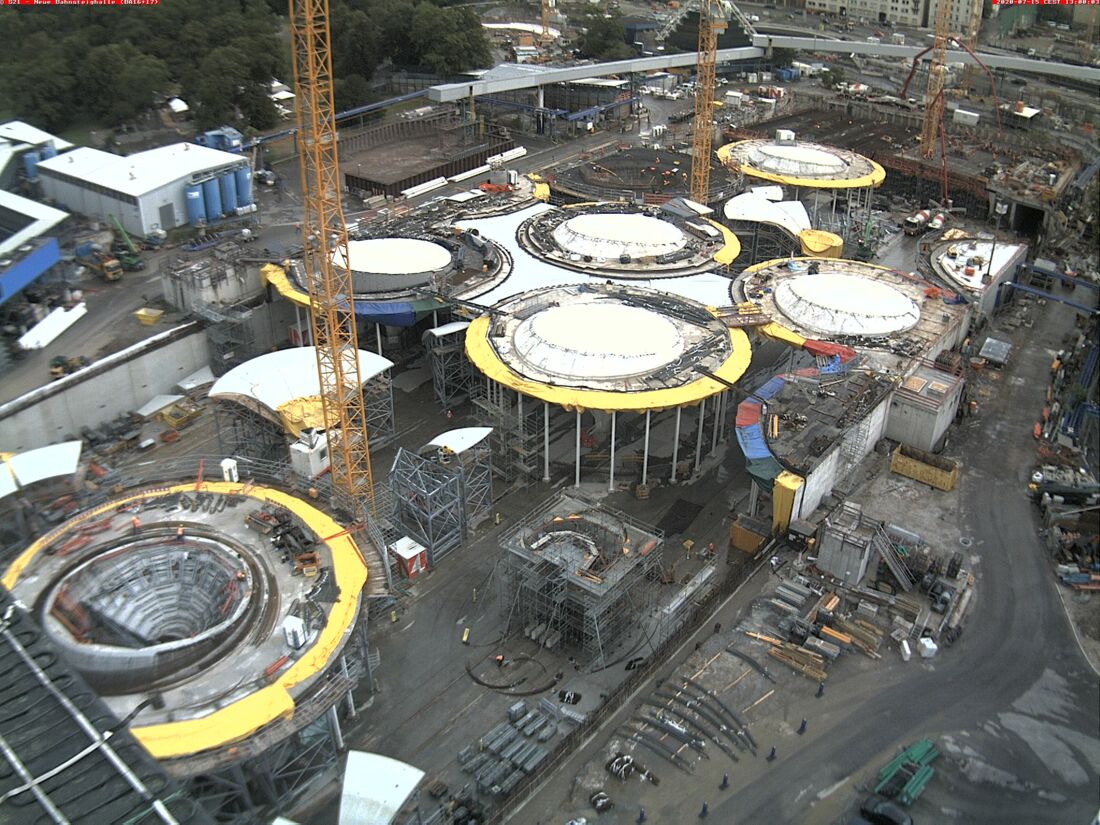
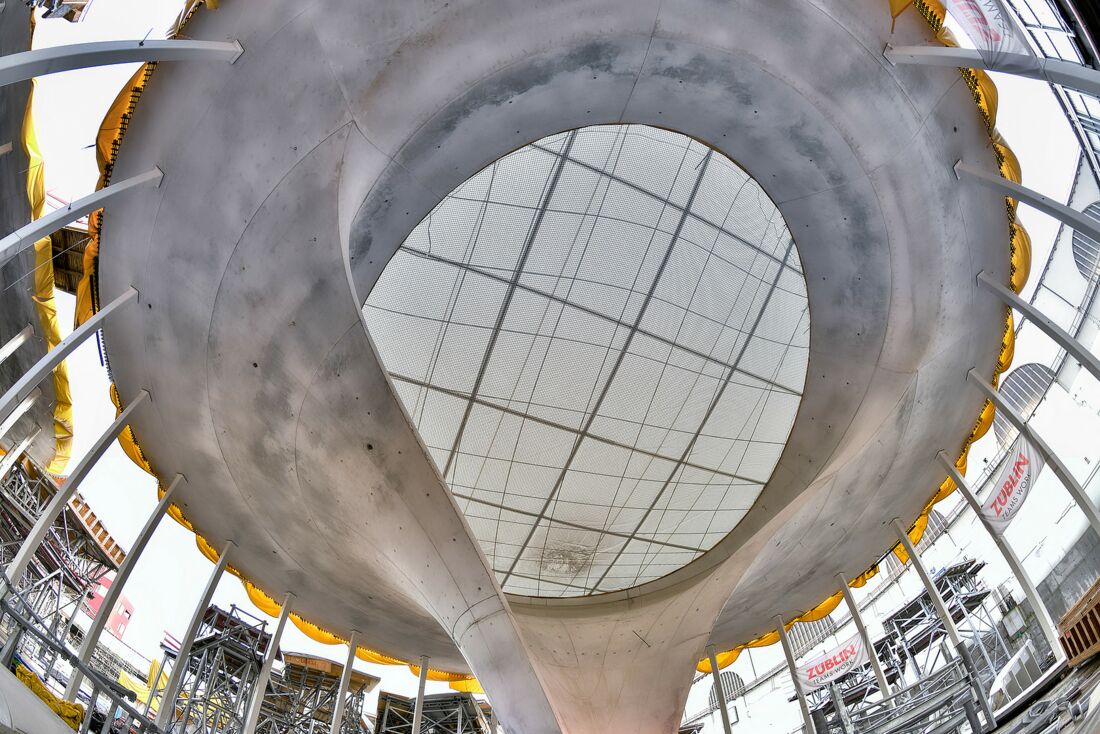
OCTOBER 2019
Chalice-structure takes shape and inspires!
Currently, a total of 3 sets of scarves for the "Regelkelche" and additional towers for the "Regelkelche" have been delivered. Thus, the formwork and reinforcement work is currently running parallel on 2 "Randkelchen" and 2 "Regelkelchen".
The form and structure of the future station are becoming increasingly clear and are also inspiring the art scene. Cultural events for the public have already been performed under the first "Regelkelch".
JULY 2019
The work steps in the processes of the large-scale project S21 are currently being repeated. We will keep you up to date!
MARCH 2019
It continues successfully!
In March the second cup was reinforced with our support (in the middle of the photo). At the same time the next "Regelkelch" with a second tower unit from ROBUSTA-GAUKEL was in progress. This was already concreted at the beginning of March.
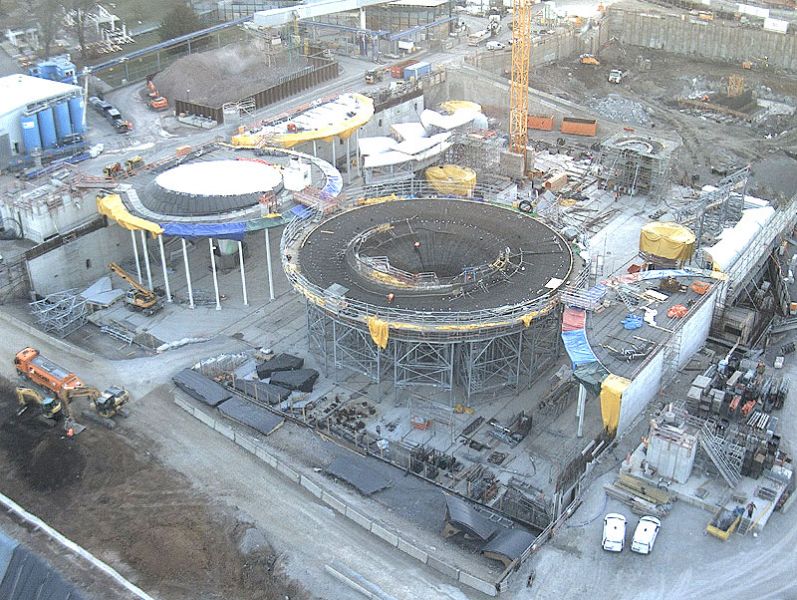
FEBRUARY 2019
Visions become reality
An exciting moment: the first chalice-shoulder was struck! The team of architects pays particular attention to its geometry.
Work on the first "Randkelch" continued rapidly with the completion of the. Gradually the chalice was unveiled and the curved shape was visible for the first time!
The architect's visions became visible reality: The last formwork element (approx. 5 tons dead weight) was safely lifted after concreting the hood with our special lifting devices. The hood is then completely visible for the first time!
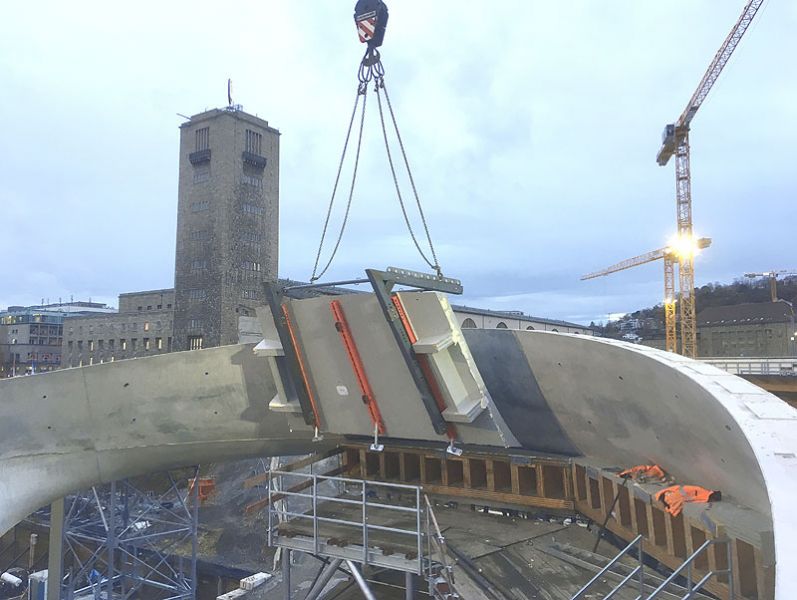
DEZEMBER 2018
FIRST "RESTKELCH": The work for stripping the forms has finished! Take a look now!
(© Deutschen Bahn AG)
NOVEMBER 2018
First "Restkelch": the work for stripping the forms has started! Look for more details!
(© Deutschen Bahn AG)
UP TO OKTOBER 2018
The tower units now with their wooden formwork pieces in position stand between the chalice structure and the covered chalice foot. Without the aid of a crane, these towers were lowered and moved to the side unproblematically in a very short time using the especially developed heavy-duty platform carriage.
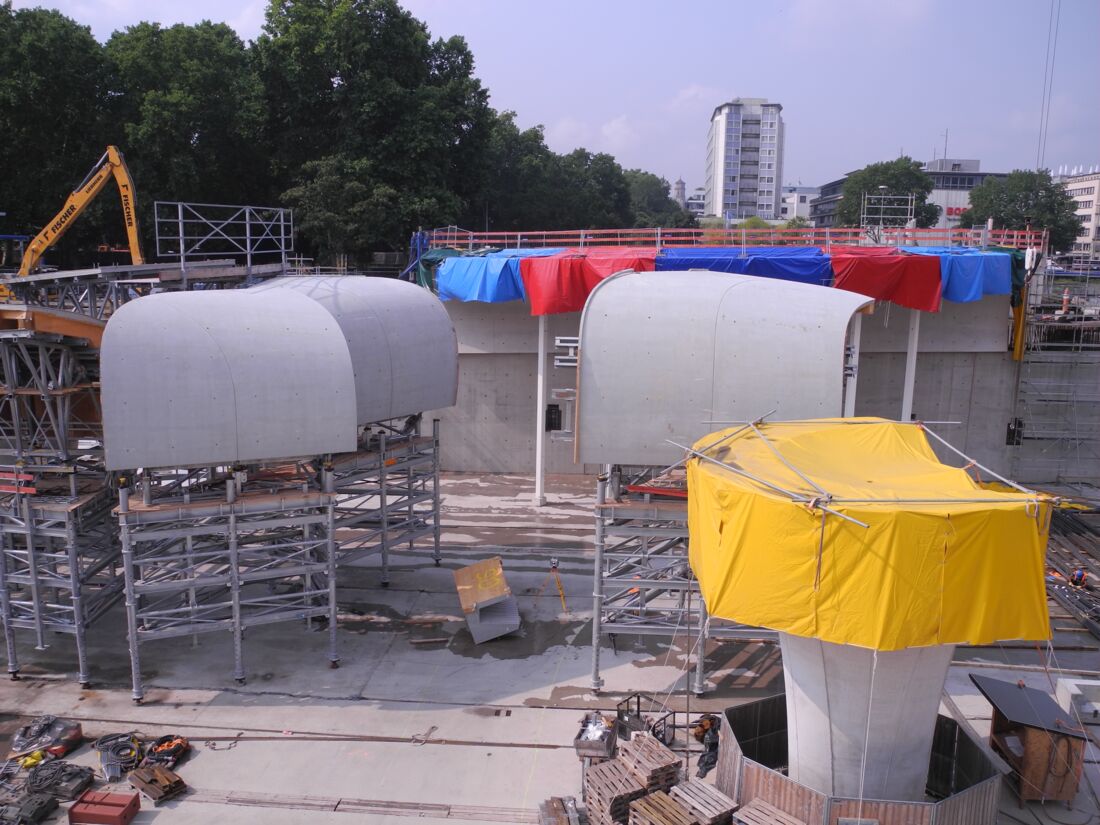
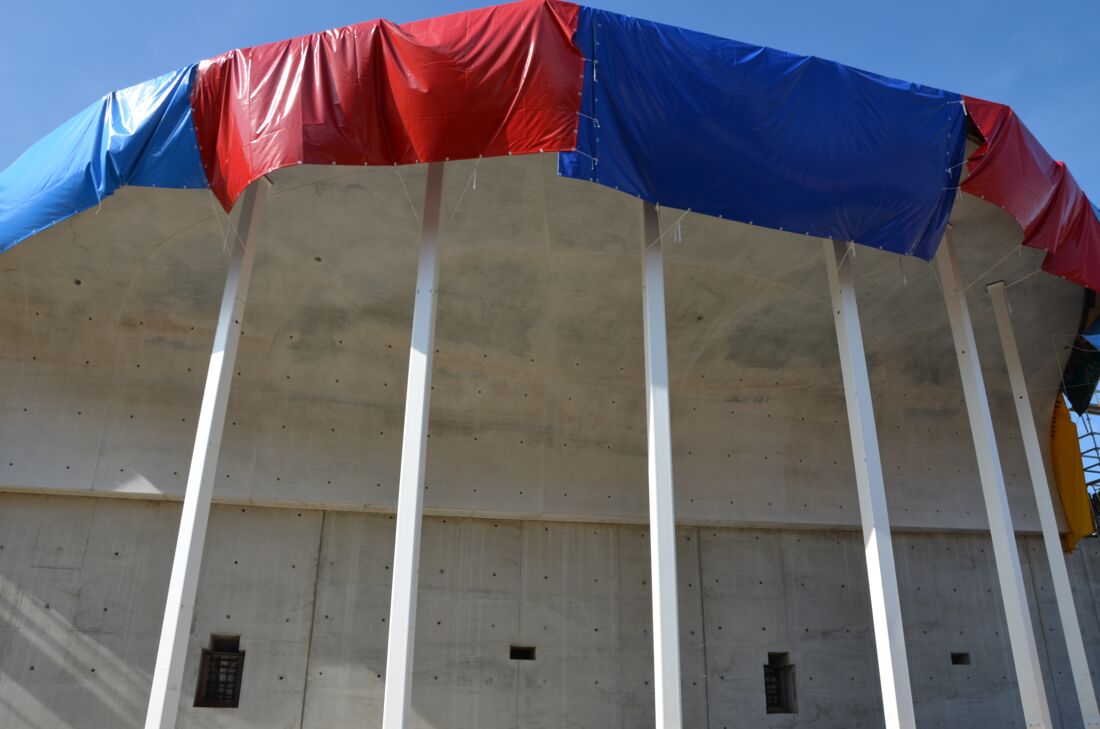
ROBUSTA-GAUKEL supplied special templates for the complicated reinforcement configuration at the transition point from the chalice to superimposed hood. The prefabricated reinforcement cages were hoisted in by crane using these templates, which are painted in different colours for the various areas. They will remain installed until the reinforcement work has been completed so that positioning is secured on an ongoing basis.
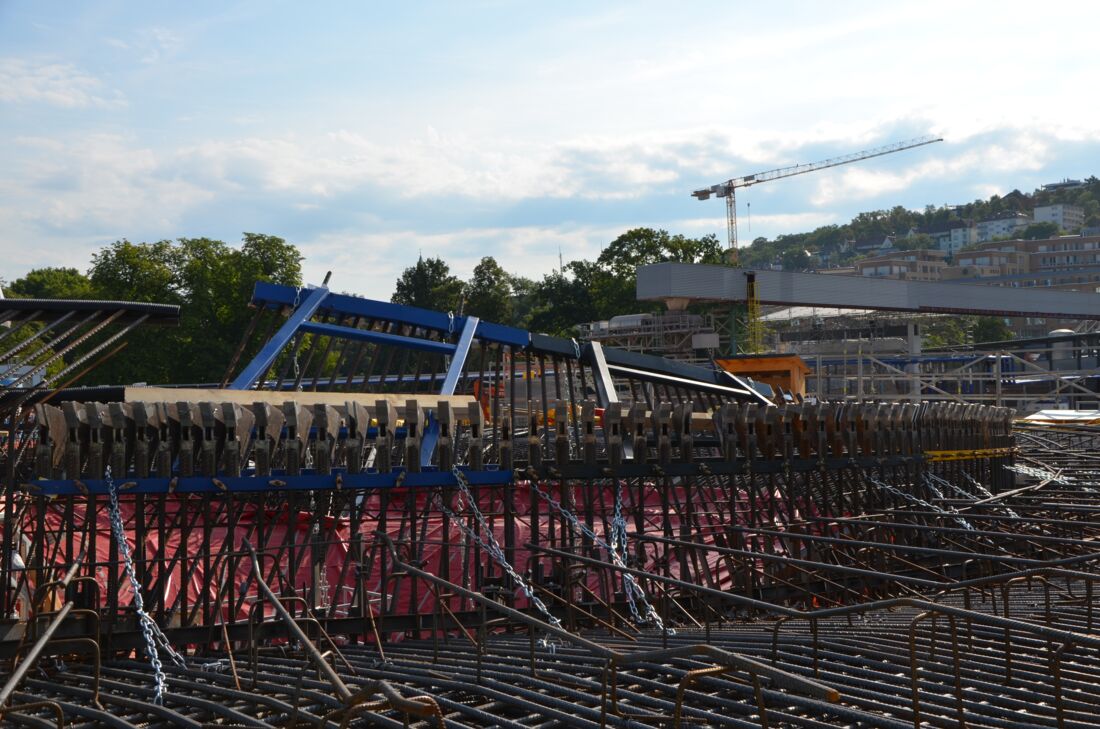
Formwork pieces for the covering formwork
These pictures illustrate the formwork pieces for the covering formwork. They are divided up into 30° strips like orange peel and still have to be screwed together with special braces before being set in position on the reinforcement. ROBUSTA-GAUKEL undertook the design engineering and manufacture of these braces in a similar way to the specially developed rotating and transportation device for safely moving and turning the extremely heavy formwork parts with one piece weighing up to approx. 4.5 tonnes.

UP TO AUGUST 2018
The first stage will see the chalice foot concreted up to the 6 m level. This chalice foot will then be shielded with a specially designed protective cover, as with a cape, until subsequent formwork can be set up for the chalice as part of the roof structure. This means that the facing concrete surface is safely protected from contamination and rust marks.

An impressive sight: the lower scaffolding has been completely fitted out with formwork for the “Randkelch”. This scaffolding is composed of up to 75% of the towers from the “Regelkelch” itself. The circumferential working platform fastened to the upper towers can be removed if necessary. At the picture’s right-hand edge, there is a separate scaffolding tower built up with office containers. Steel fixers can find information here directly on site about the complicated reinforcement configuration using an interactive 3D model at a PC terminal. The reinforcement for the “Randkelch” is made up of approx. 11,000 positions!

UP TO JULY 2018
Formwork stripping:
In July 2018, work was commenced on stripping the formwork. The first external tower segment was slowly lowered at a 30° angle with the aid of a special carriage and withdrawn with great accuracy. The upper tower initially had to be lowered to an angle below 45° with the aid of built-in hydraulic cylinders so that the formwork could be stripped from the interior tower segment. It was only then possible to move the whole tower unit on the carriage.
Once 2 temporary supports had been installed in the 30° segment, the towers were fitted out in the adjacent segment section.
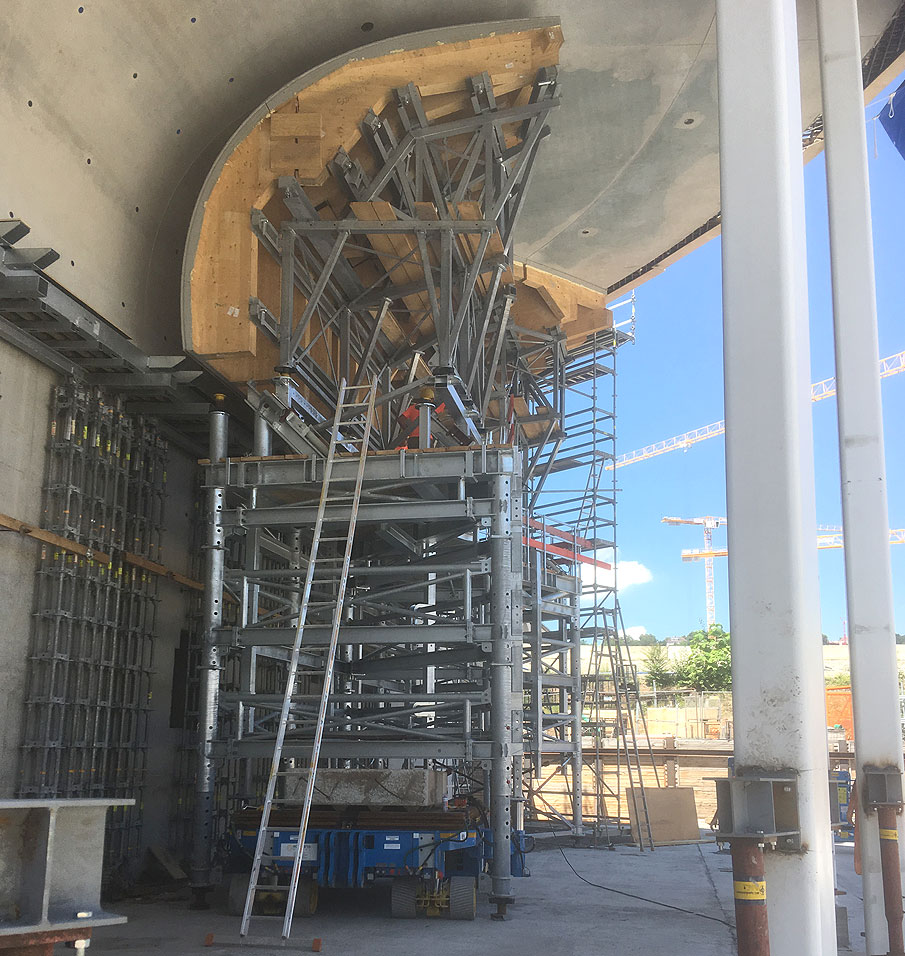
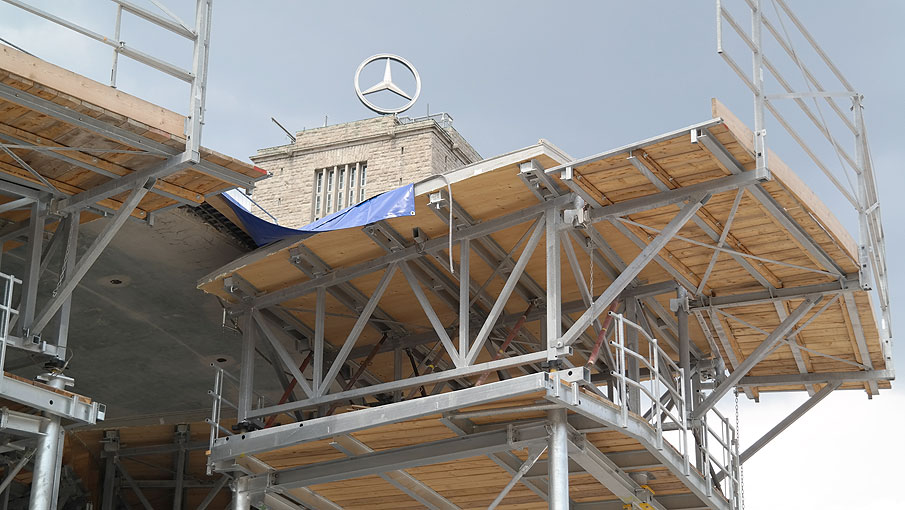
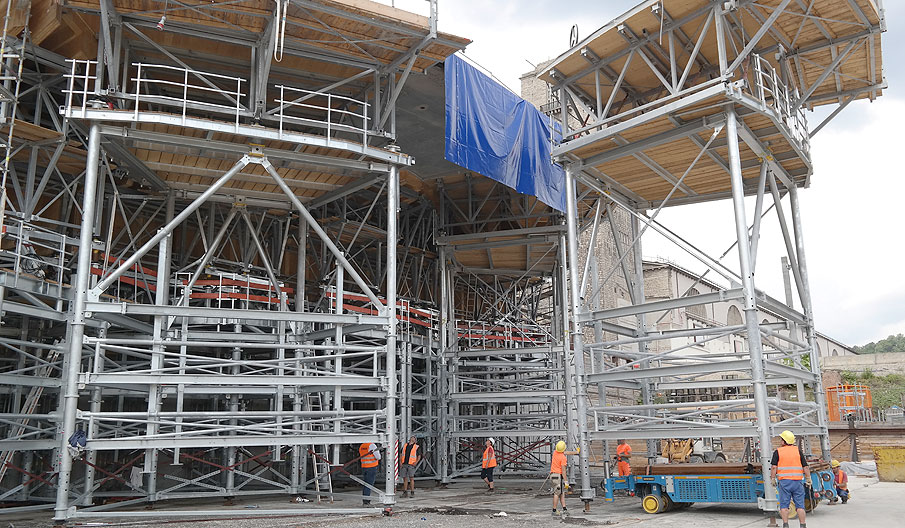
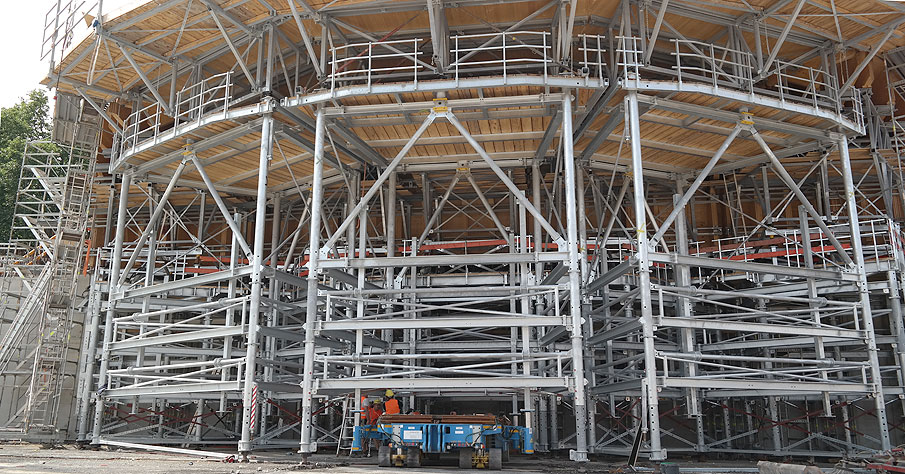
JUNE 2018
Concreting the “Restkelch” superstructure:
Everything was ready on 30th June. The first “Restkelch” superstructure was concreted. Approx. 460 m³ concrete were installed with 2 concrete pumps in about 6 hours – 200m³ alone in the two last hours!
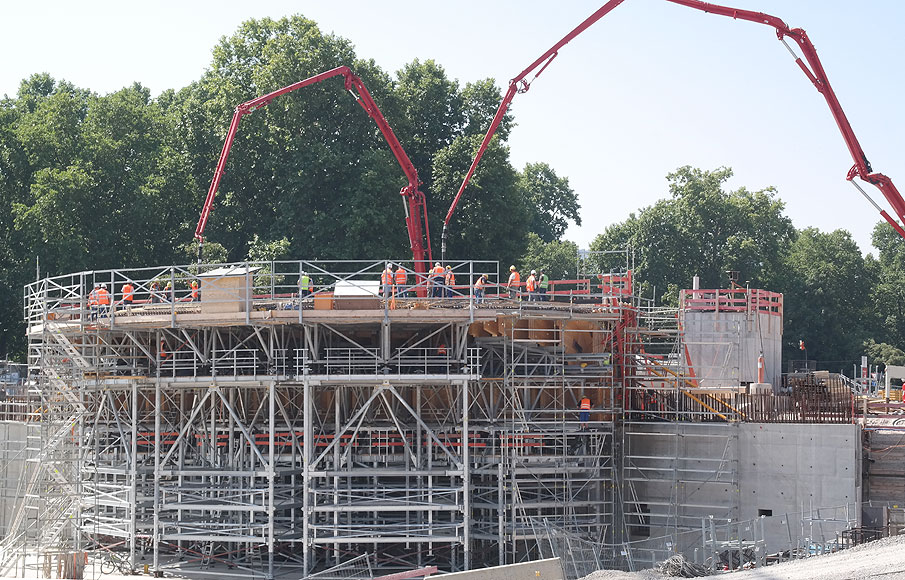
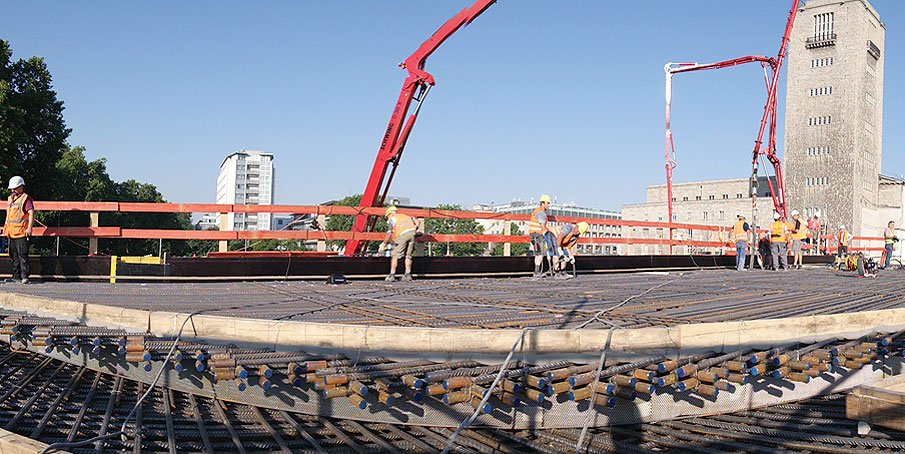
Scaffolding has in the meantime been erected completely around the first “Randkelch”. Its elaborate reinforcement was installed whilst other work on the “Restkelch” was being carried out. Once the formwork towers with their complex timber formwork had been set up and aligned, more than 160 tonnes of reinforcing steel were installed!
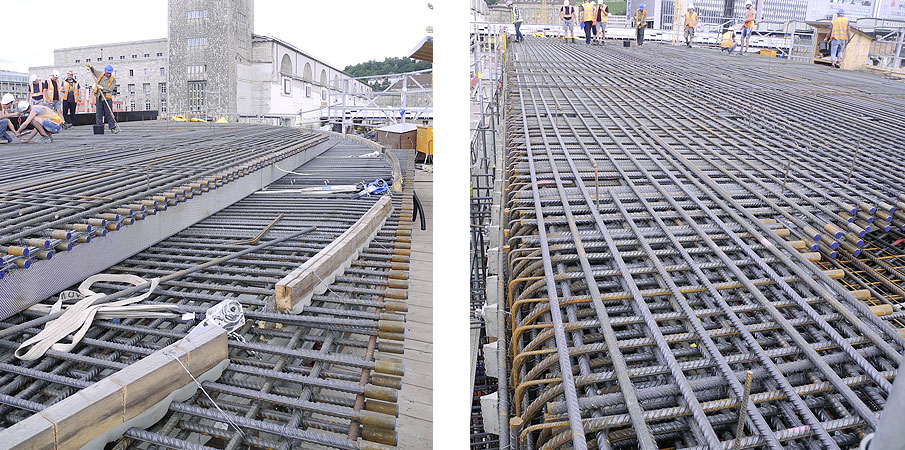
SINCE END OF FEBRUARY 2018
The first “Randkelch” - reinforcement work
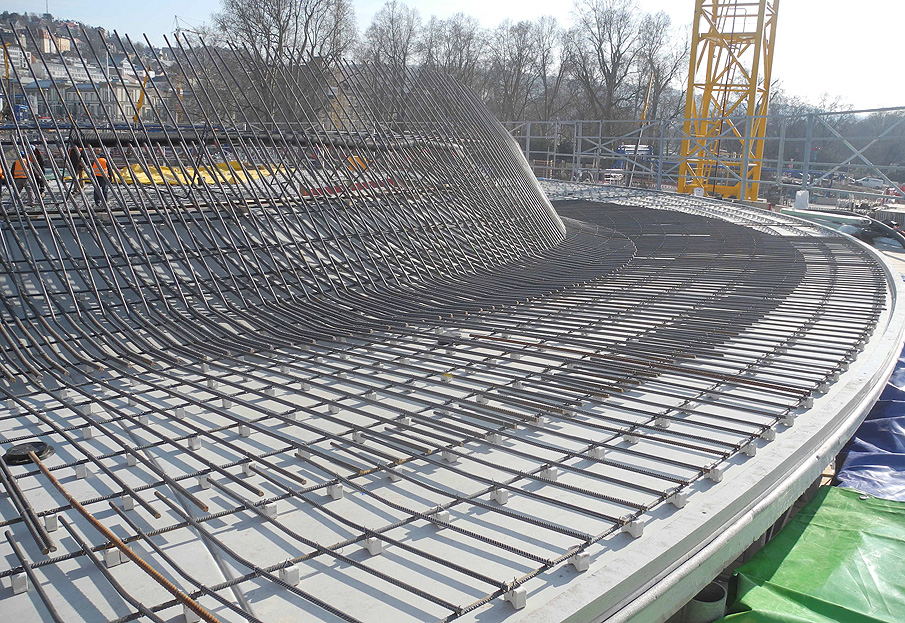
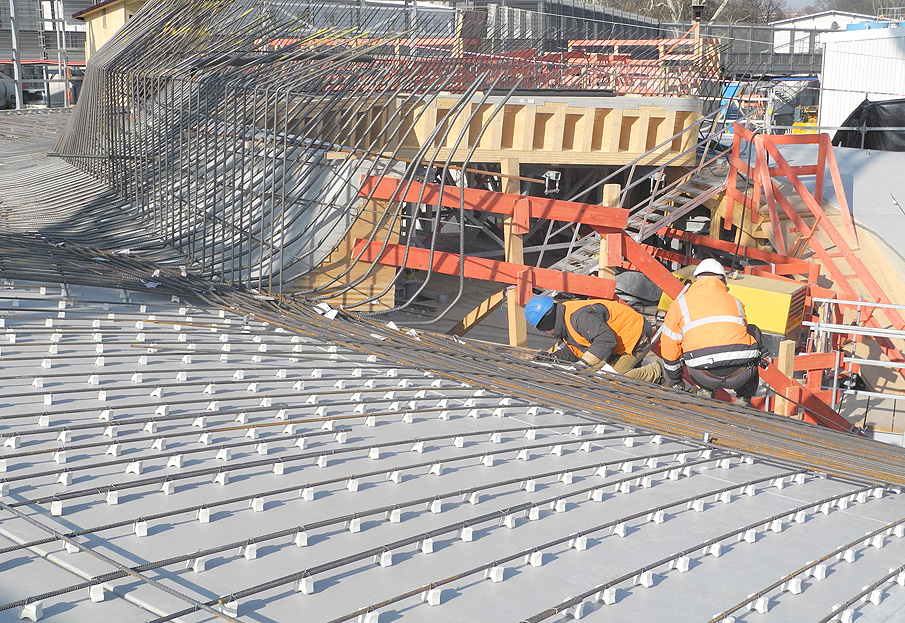
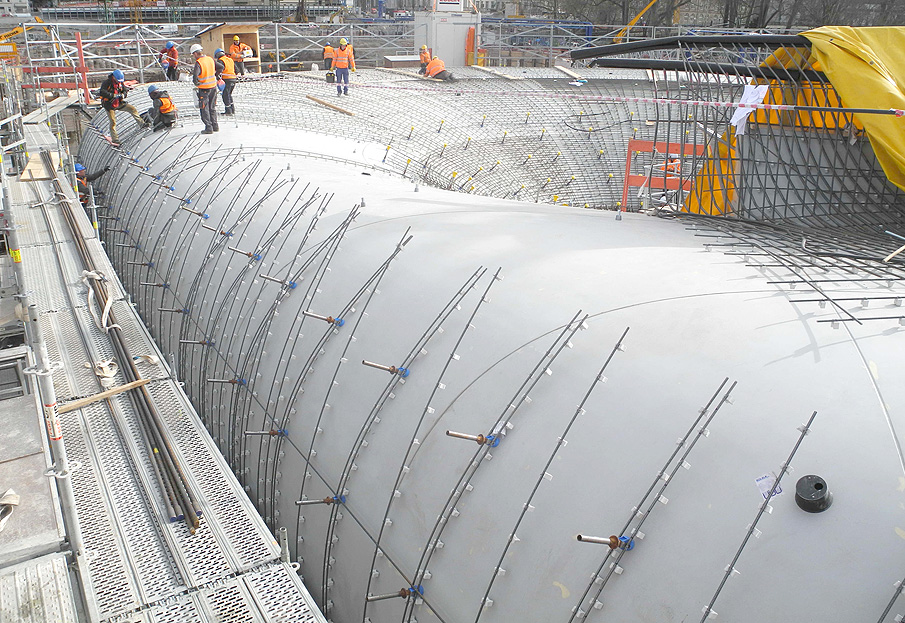
JANUARY – FEBRUARY 2018
The first “Randkelch” – setting up formwork
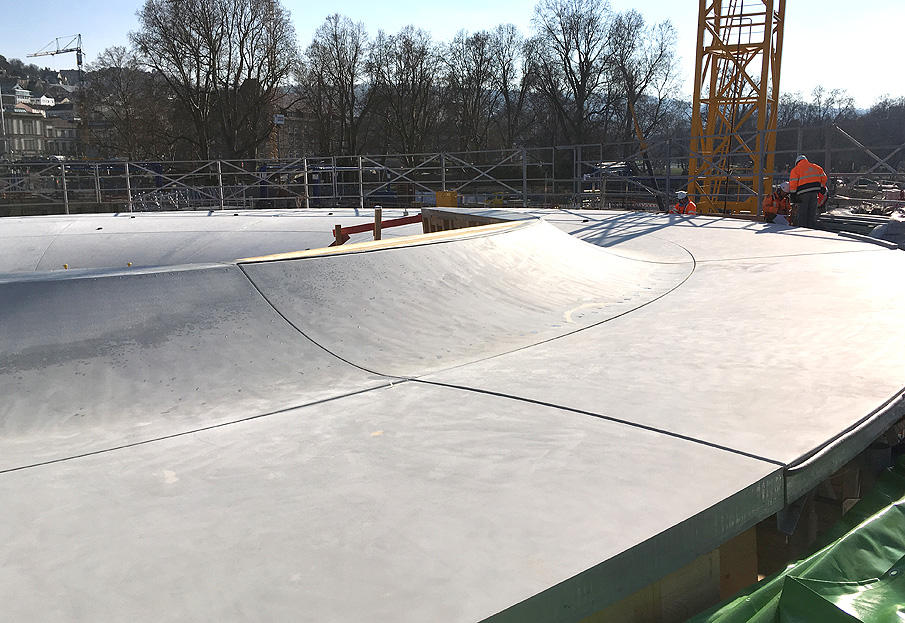

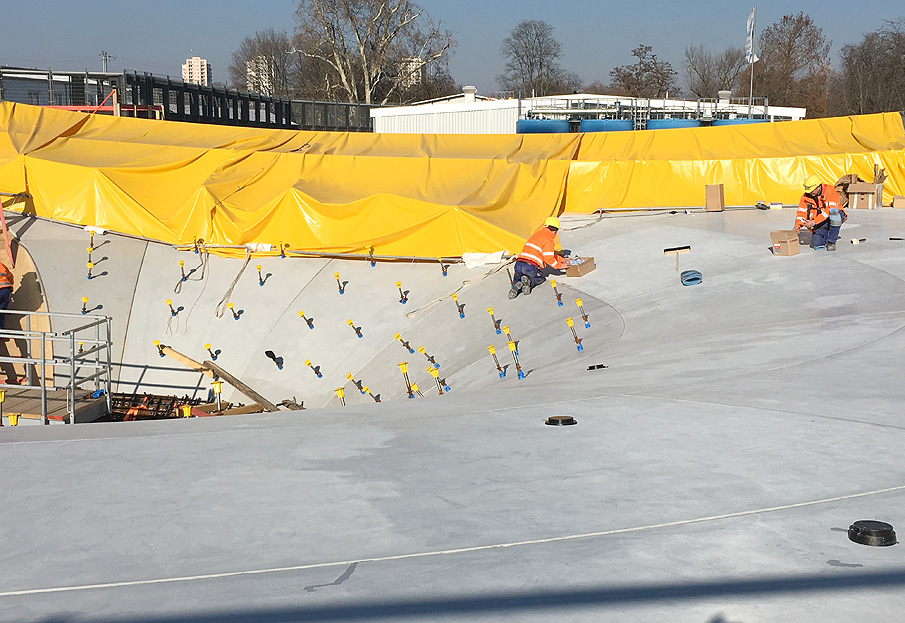
SEPTEMBER – NOVEMBER 2017
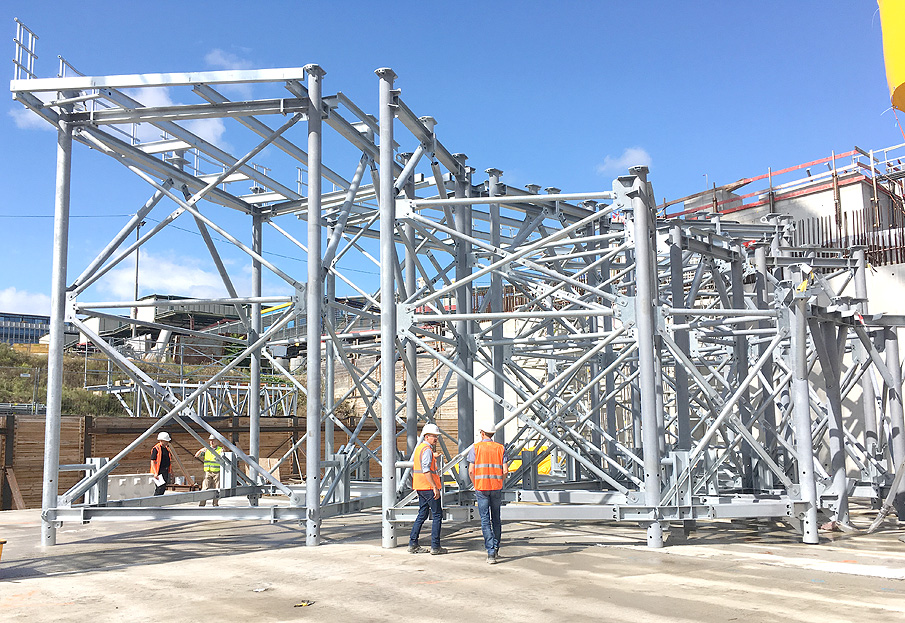
The first "lower" towers are set up around the chalice foot.
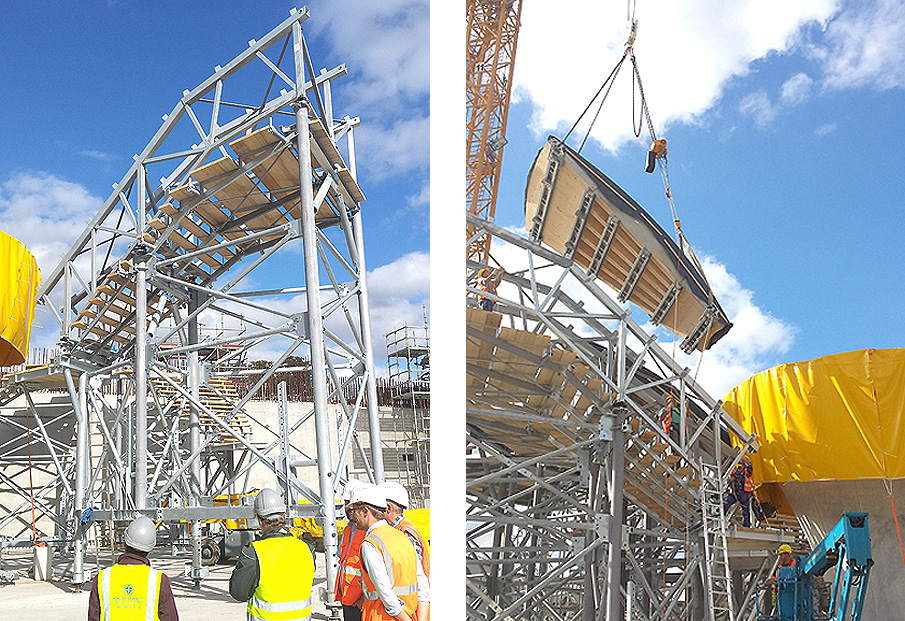
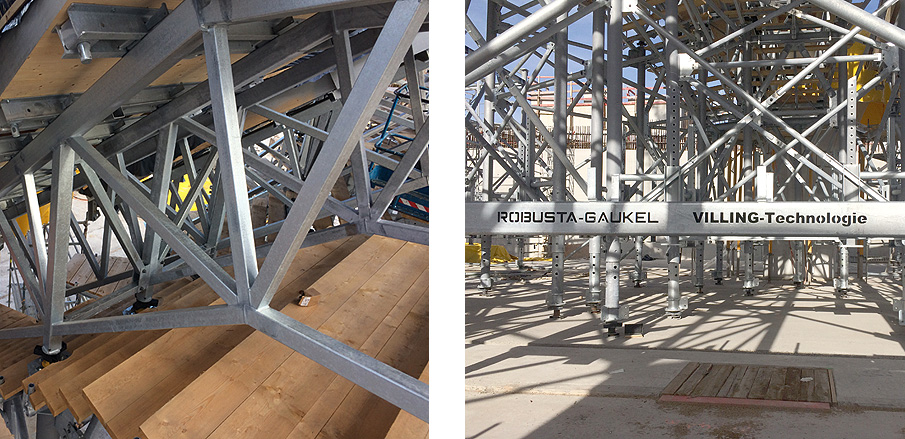
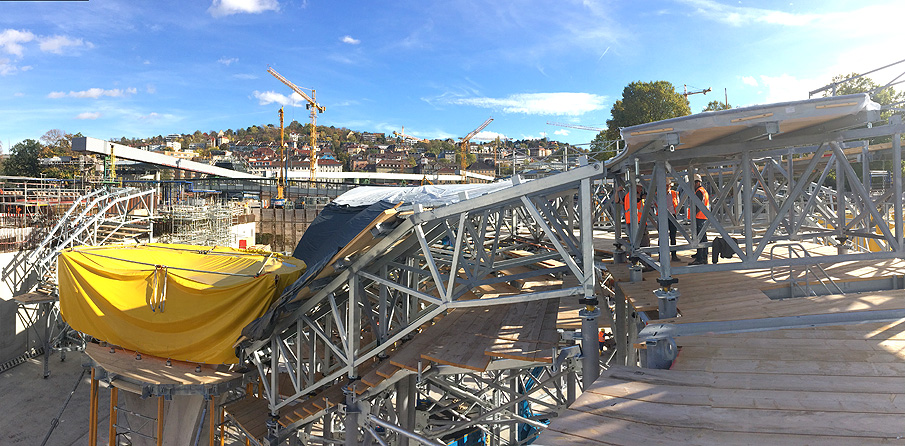
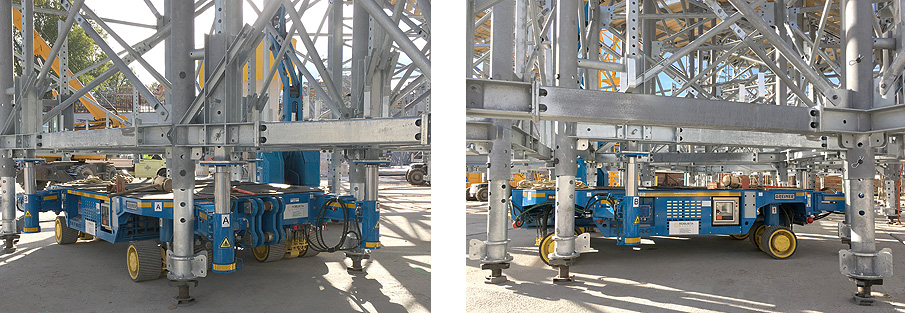
A heavy-duty platform carriage was developed purposely for transferring and moving the extremely heavy tower units without a crane. This carriage has additionally been equipped with 4 swivelling lift cylinders, which were flange-mounted on its sides in different positions, making it possible to adapt the cylinders’ position to the varying tower shapes.
AUGUST 2017
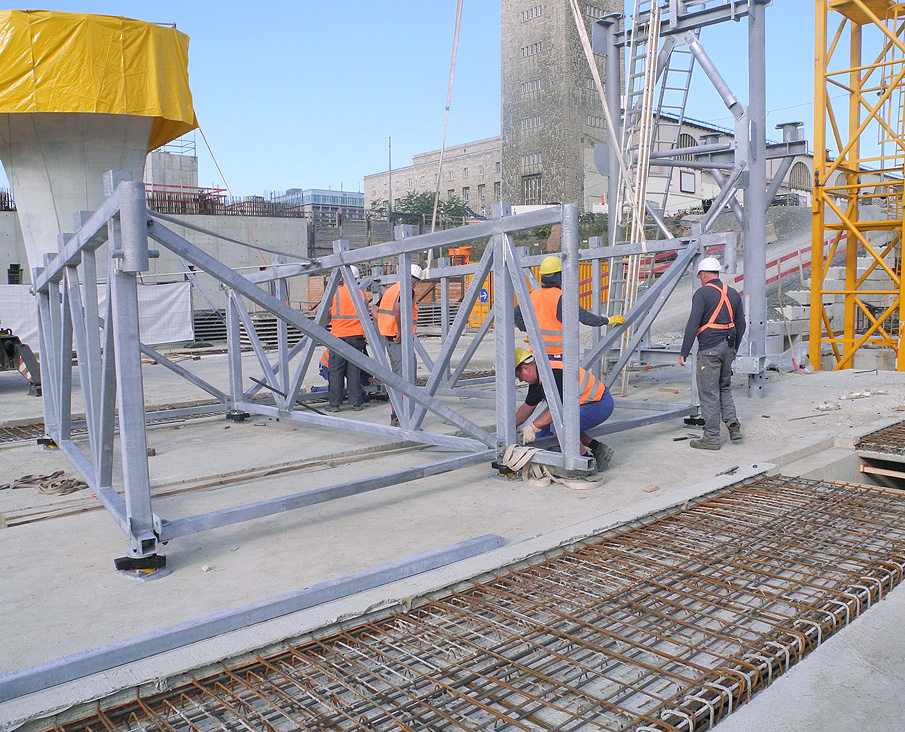
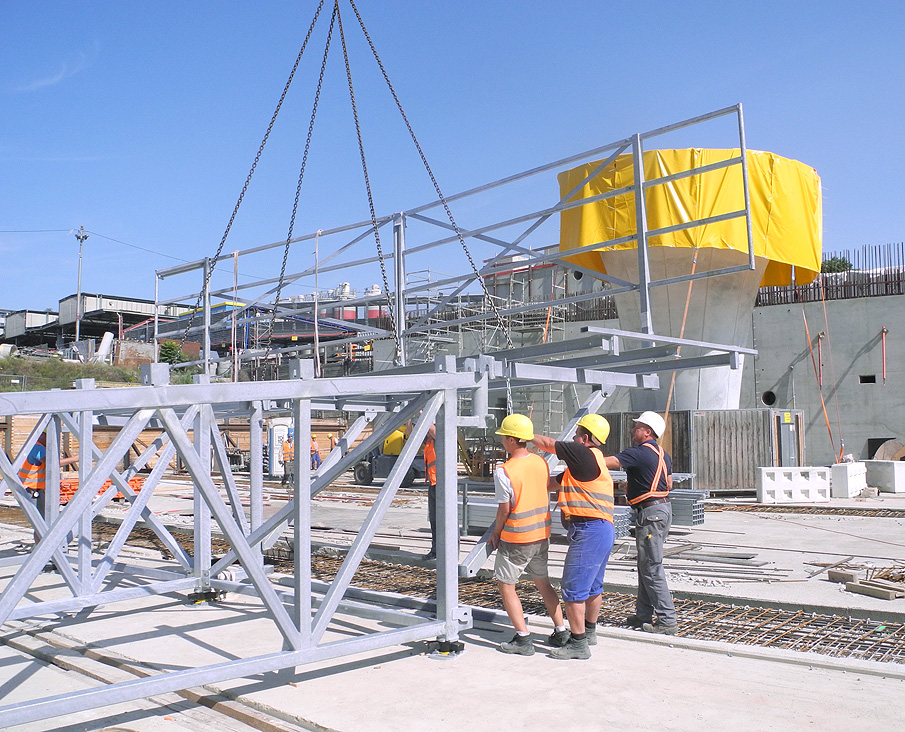
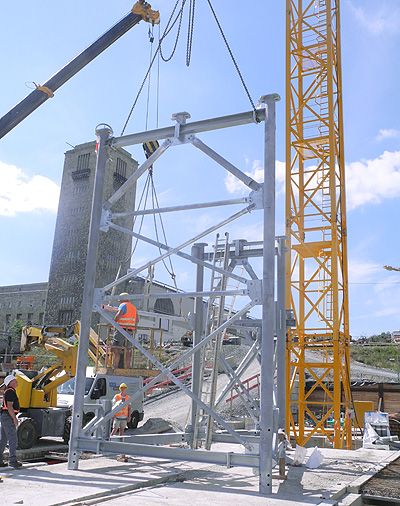
After the test set-up it was then possible to supply the first elements. The first galvanised tower units were assembled on 22nd August at the construction site. Supervisors from ROBUSTA-GAUKEL and Villing were on site in an instructive and supportive role.
First picture: The first tower built up of 3 truss girders has already been mounted complete with all diagonal struts. This will later support 1/12 of the outer wooden formwork with bracing belts screwed in underneath. The fan-shaped arrangement can be clearly recognised, already giving a hint of the circular chalice-like layout.
Second picture: Immediately following this, the working platform (still without a wooden covering) was secured in place.
Picture left: Assembly work continued on the inner lower tower in the afternoon. Its size is impressive, taking into consideration the fact that the final support height has not yet been reached, since another tower will be erected on top.
JULY 2017
Formwork scaffolding test set-up
In brilliant sunshine, the first 30° segment of the formwork scaffolding for the characteristic chalice columns of the future Stuttgart railway station was built up for testing purposes.
Approx. 20 tonnes of steel were installed on a base area of approx. 8.20 m x 14.0 m with a height of up to approx. 11.0 m in order to absorb the forces generated during the concreting process.
This test set-up worked out to the complete satisfaction of the site management as well as the design engineers and others involved.
The components were subsequently dismantled and galvanised for optimum protection during the entire construction time. This makes it possible for them to be utilised unproblematically on a permanent basis for the many years the construction work will take.
Shortly afterwards, a total of 12 such segments was delivered to be assembled as the full and final scaffolding for the chalice column formwork with a diameter of more than 30 metres.
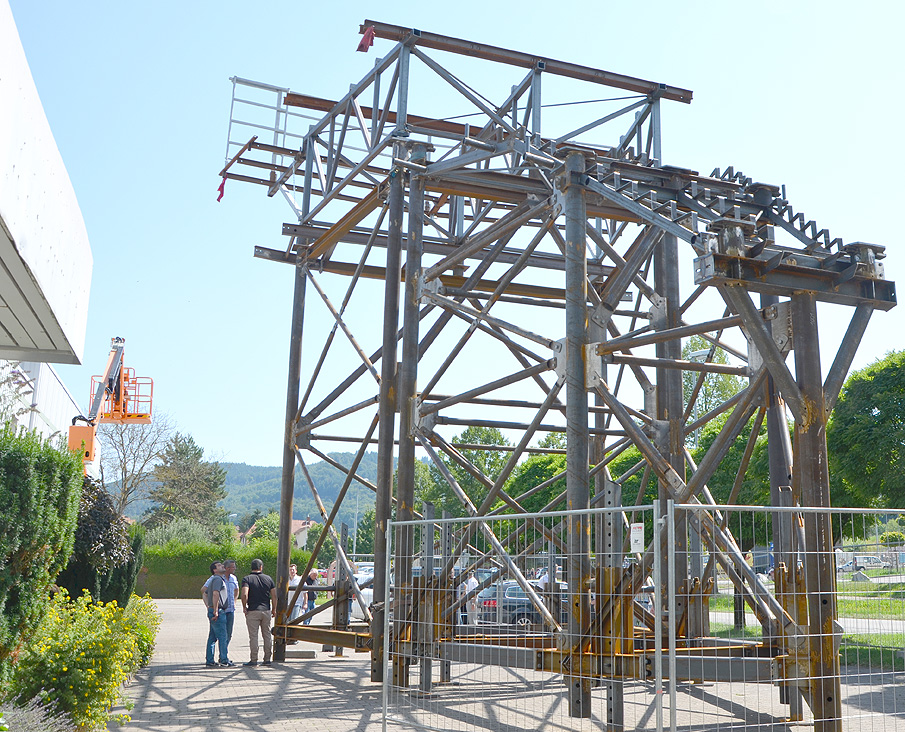
JUNE 2017
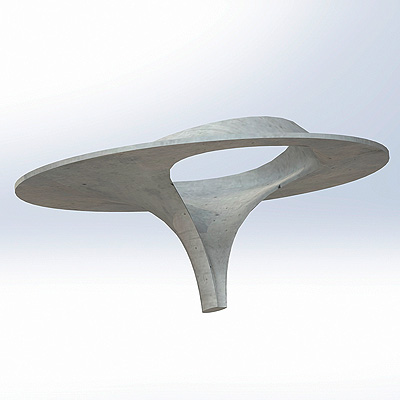
The time had come after exhaustive planning… The first chalice foot had been successfully cast in concrete. The following ROBUSTA products were employed in this work:
Special bracing belts made with HEB beams
The complete formwork was put together from 4 timber elements. These were then “wrapped round” like a barrel with the bracing belts – structural computations and manufacture by ROBUSTA-GAUKEL – to counter the inner hydrostatic pressure.
Self-propelled special heavy-duty carriage
This was manufactured specifically for this construction project and was additionally equipped with 4 lifting cylinders flange-mounted at its sides on the frame. These special cylinders, each with 10 tonnes load-bearing capacity, are installed on telescopic arms that can also swivel sideways so that the scaffolding towers for the lower chalice formwork can be moved without a crane.
Special lifting mast on the heavy-duty carriage
It is not possible to set the chalice foot formwork elements in place by suspending them from a crane on site on account of the reinforcement projecting from the side above. A special lifting mast was designed, structurally computed and produced by ROBUSTA-GAUKEL for the purpose of transporting single formwork elements independently of a crane. The lifting mast was bolted onto the carriage’s front side; two of the swivelling cylinders were utilised for hoisting and lowering.
We would also like to thank our partners Villing-Technologie / Friesenheim and Greiner / Neuenstein for their contribution to the success of the operations.
A spectacular video can be found here: Concreting the first chalice column
MAI 2017
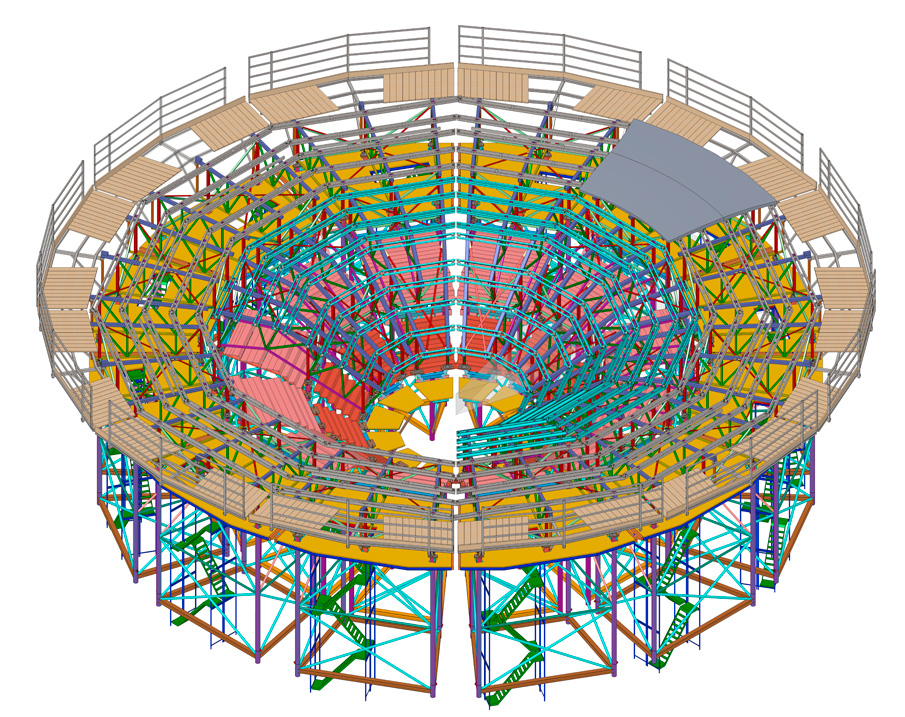
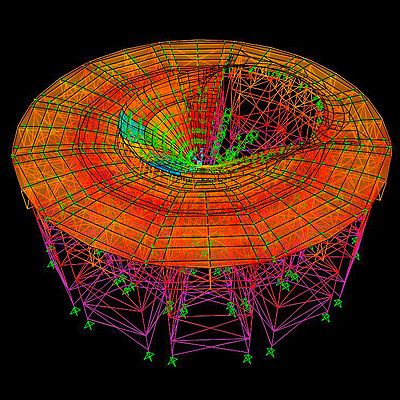
Upper picture: Study into supporting the formwork shell for the “Regelkelch”.
The Stuttgart-Ulm railway project, one of the biggest infrastructure projects in Europe at the current time, also includes in its core area the urban traffic and development project known as Stuttgart 21 for transforming the existing terminus railway station into an underground through station.
The new construction of the railway station concourse forms the main building project with the greatest public attention. The building coming into being according to the design of Christoph Architects is characterised by its striking oversized chalice-shaped columns. The construction contractors, Ed. Züblin AG, have entrusted ROBUSTA-GAUKEL with the design and manufacture of the support structure for the formwork units with a view to implementing these chalice columns. The formwork units, themselves, are produced by Züblin Timber.
The extremely complex shape of the chalice columns – their like has never been implemented in concrete up to the present time – does not permit any approach using well-known computational methods. Very elaborate and demanding calculations were necessary for determining the loads occurring. It was also not possible to utilise standard scaffolding systems in view of the given loading and planned construction progress. At the current time, special steel structures for this construction work are being produced at our facilities with support from our partner Villing Technologie in Friesenheim.
We are pleased to be involved in this distinctive city landmark.












